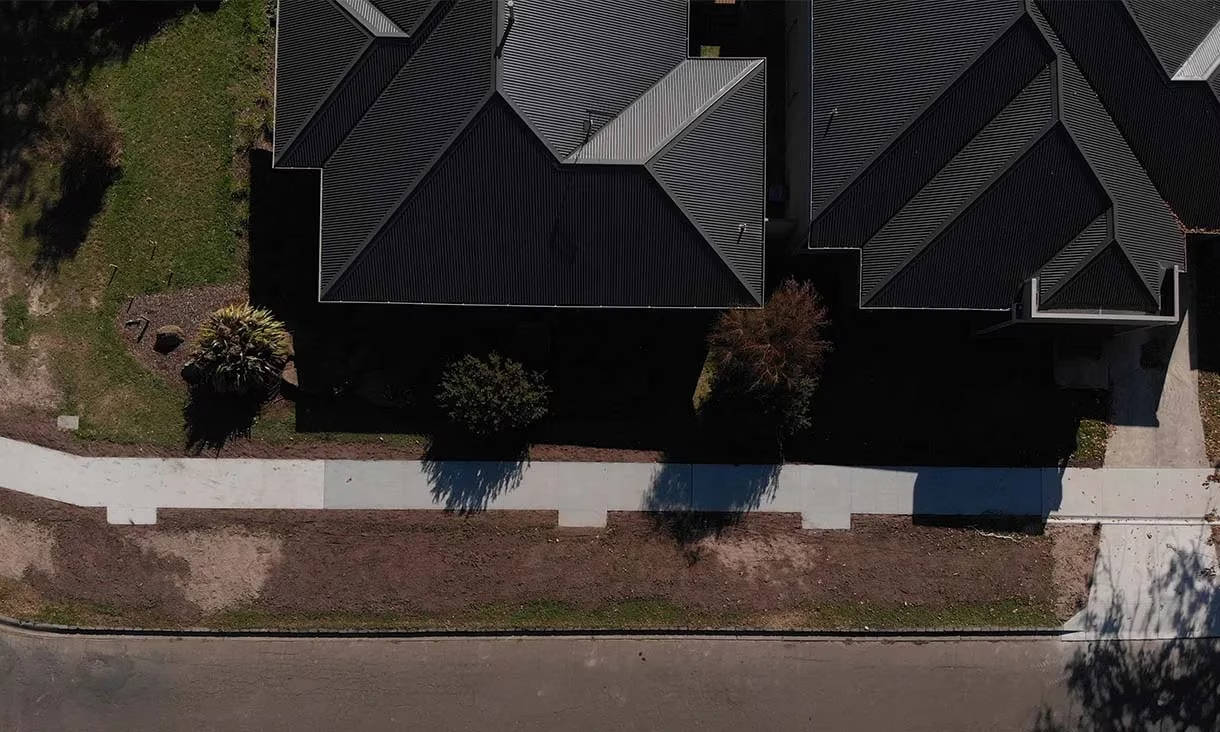The researchers turned ground coffee waste into biochar and used it as a replacement for river sand in concrete.
 The first pour of the coffee concrete for the footpath trial in Gisborne. Carelle Mulawa-Richards, RMIT University
The first pour of the coffee concrete for the footpath trial in Gisborne. Carelle Mulawa-Richards, RMIT University
Researchers at RMIT University and members of the Macedon Ranges Shire Council in Australia have collaborated to trial the world’s first footpath made using coffee concrete. Although coffee smells will not welcome footpath users, the attempt is a major step forward in eco-friendly constructions.
 Aerial view of the finished footpath in Gisborne. Image credit: Chris Matthews, Macedon Ranges Shire Council
Aerial view of the finished footpath in Gisborne. Image credit: Chris Matthews, Macedon Ranges Shire Council
Australia generates 165 million pounds (75 million kgs) of ground coffee waste annually, most of which end up in landfills. Along with other organic materials that aren’t processed, landfills contribute 3% of greenhouse emissions.
Rajeev Roychand, a postdoctoral researcher, and his colleagues at RMIT University were keen to use this valuable resource instead of letting it decompose in landfills. Organic waste cannot be directly added to concrete since it will decompose over time and weaken the construction.
Concrete with biochar
The researchers, therefore, turned to biochar, a rich solid mass of carbon made using partial combustion of organic waste. By heating ground coffee waste to temperatures of 662 Fahrenheit (350oC) in the absence of oxygen, the researchers made coffee biochar to increase the life of the waste and make it suitable as an ingredient in concrete.
 The pour of the coffee and wood-chip biochar concrete for the footpath trial in Gisborne took place earlier this month. Image credit: Bodey Dittloff, Macedon Ranges Shire Council
The pour of the coffee and wood-chip biochar concrete for the footpath trial in Gisborne took place earlier this month. Image credit: Bodey Dittloff, Macedon Ranges Shire Council
A similar approach was used for processing wood chips, another organic waste seen in landfills. The biochar replaced the river sand in the concrete mix, and footpaths in Gisborne were laid down.
“Sand is getting scarce over time, and this waste can replace up to 15 percent of the sand in concrete,” said Roychand. The 165 million pounds of coffee waste, since it is much denser, can replace over 1,400 million pounds (655 million kg) of sand in concrete.
At a global level, about 22 billion pounds (10 billion kgs) of ground coffee waste is generated annually, which could potentially replace nearly 200 billion pounds (90 billion kgs) of river sand used in concrete.
Making less concrete cement
“We’re taking those experiments and putting them in ground and in the field today, we’re going to have people walking across the concrete that includes these products and RMIT is going to be coming back and doing testing to see how they stand up,” said Shane Walden, Director of Assets and Operations at Macedon Ranges Shire Council in a statement.
Using biochar helps us work toward a greener planet and can also save companies’ costs.
 A concrete sample undergoing a strength test in the researcher’s lab at RMIT University. Credit: Carelle Mulawa-Richards, RMIT University
A concrete sample undergoing a strength test in the researcher’s lab at RMIT University. Credit: Carelle Mulawa-Richards, RMIT University
“Our research creates a potential even to reduce the required cement content. Since we are achieving a 30 percent increase in strength for the coffee concrete, this could reduce the required cement content by as much as 10 percent,” Roychand added in the press release.
The recently made footpath did not use less cement, but RMIT researchers are already working in this direction. The hurdles in the process largely come from the organic waste used to make biochar. The carbon content, particle size, and absorbency can vary but can also boost the strength of the cement in many ways.
“We are currently working in the supply chain sector so that we can make this research into a mainstream product for commercial applications,” Roychand concluded in the statement.
Source: Interesting Engineering’s News
(https://interestingengineering.com/innovation/coffee-concrete-footpath-australia)

